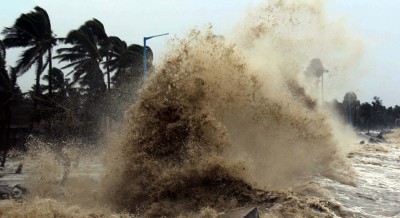
New Delhi, The 2020 North Indian Ocean (NIO) tropical cyclone season was the costliest in recorded history, with damages amounting to excess of $16 billion, the 'State of Climate in 2020' report said.
"The majority of the damage was driven from the impacts associated with Super Cyclone Amphan, amounting to $13.9 billion," said the report prepared by the American Meteorology Society.
The report, prepared by more than 530 scientists from over 60 countries, including India, was released in the US on Wednesday.
There were 102 named tropical cyclones across all ocean basins last year, well above the 1981-2010 average of 85 storms. Of these, three tropical cyclones reached Category 5 intensity.
The North Indian Ocean (NIO) tropical cyclones season typically occurs between April and December, with two peaks in activity: May-June and October-December.
These are caused by the presence of the monsoon trough over tropical waters of the NIO during these periods. The Bay of Bengal, on an average, experiences four times more tropical cyclones than the Arabian Sea.
"The damage associated with Amphan was estimated to be at $13.9 billion, the costliest cyclone recorded in the basin. In India alone, 98 deaths were reported, along with fatalities in Bangladesh and Sri Lanka. West Bengal was most impacted by Amphan.
"In June, the Indian Red Cross Society reported that 2.9 million houses in the state were damaged or destroyed. A 24-hour accumulated rainfall of 240 mm was recorded at Alipore, and storm surge of approximately 15 feet inundated low-lying areas of West Bengal. Bhutan was also affected by flash flooding," the report said.
"Cyclone Nisarga resulted in six fatalities and damage of over $800 million was reported. Farmers living along the coast of Raigad and Ratnagiri in Maharashtra suffered devastating losses, and crops including coconut, betel, and mango were destroyed. Significant rainfall (190 mm) was reported at Mahabaleshwar (Maharashtra), and up to 130 mm was reported at Mormugao (Goa) by the Indian Meteorological Department," the report said.
"Cyclone Nivar (November 23-25) formed in the Bay of Bengal and tracked toward the west-northwest, passing to the northeast of Sri Lanka. On November 25, Nivar made landfall crossing the Tamil Nadu and Puducherry coasts. Nivar reportedly resulted in 14 deaths and damage of around $600 million," it added.
Former Secretary in the Ministry of Earth Sciences, Madhavan Rajeevan, who was among the three Indian scientists in the team of 530 authors, said, "The cost is estimated after calculating all kinds of losses and it also included mitigation measures such as evacuation of people and livestock ahead of the cyclones."
The American Meteorological Society's report also mentioned higher Accumulated Cyclone Energy (ACE) Index for Amphan and Gati, for which above-average ACE index values were also recorded. The ACE Index is calculated every six hours tracked globally, while the IMD does it every three hours.
Explaining the significance of ACE Index, Director General, India Meteorological Department (IMD), Mrutyunjay Mohapatra, told IANS, "If a cyclone has got more ACE, certainly it has got higher and persistent velocity. Then this cyclone has got higher damage potential. If we calculate the damage at a particular point, it is directly proportional to the square of velocity (v2). So ACE is also called the damage potential."
He also explained another index called the Power Dissipation Index (PDI).
"It is calculated using cube of the velocity (v3) and it measures the power of the cyclone to destroy things," Mohapatra added.
Major global findings of the report:
* The global annual average atmospheric CO2 concentration rose to 412.5 parts per million last year, the highest in the modern 62-year measurement record and in ice core records dating back as far as 800,000 years
* Year 2020 was among the three warmest years on record dating to mid to late 1800s
* Globally, upper ocean heat content was record high in 2020
* Global average sea level rose to a new record high at about 3.6 inches (91.3 mm) higher than the 1993 average
* The 2020 Southwest Asian Monsoon season (June to September) was the wettest since 1981
* The Arctic mean surface air temperature was the highest on record


.jpeg)

